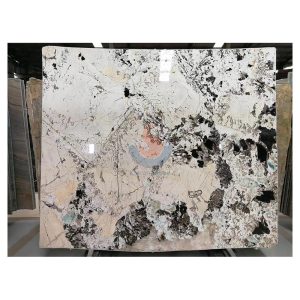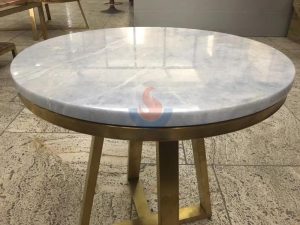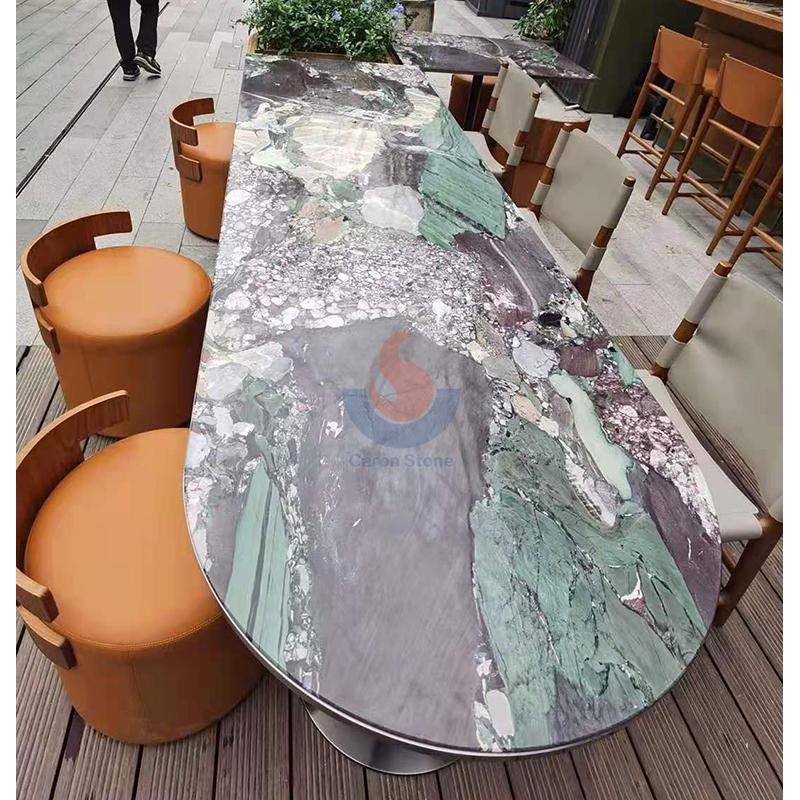When we walk into a room with marble floors, we often feel a unique coolness. This coolness seems to subtly convey the particular “temperature story” of marble, regardless of the season—hot summer or freezing winter. Still, why does marble usually feel so “cold”? This is closely related to its thermal conductivity. In this article, we will delve into the thermal conductivity properties of marble, unlock the secret of why it can maintain a unique touch in all seasons, and explore its performance in different application scenarios.

Factory direct low price luxury marble patagonia marble granite slab translucent pandora quarzite white onyx
Marble’s thermal conductivity: behind the coolness
Marble, as a natural stone, has an internal structure composed of tightly arranged mineral particles. Marble has special physical characteristics thanks in part to this structure; one of them is thermal conductivity. Thermal conductivity basically controls a material’s heat transport ability. When we touch marble, the temperature of our palms is quickly transferred to the marble surface, making us feel cool. This is so because marble can rapidly absorb and distribute heat and has a strong thermal conductivity coefficient.
In contrast, materials such as wood have a low thermal conductivity coefficient, so they do not absorb heat quickly and give people a warm touch. This “cold feeling” of marble is one of its unique charms in applications such as flooring and countertops, especially in hot climates, this calm quality is particularly charming.
Application of marble in architecture: the influence of thermal conductivity
The thermal conductivity of marble not only affects its touch, but is also directly related to its application in architecture. Marble flooring’s strong thermal conductivity helps floor heating systems to more efficiently move heat from under the floor to the interior space. Compared with wooden floors or carpets, marble can heat up faster and provide uniform heat distribution in the room. Marble is thus a perfect alternative for floor heating systems in many luxury buildings and upscale residences.
However, the thermal conductivity of marble also has its limitations. In the cold winter, unheated marble floors may appear too cold and uncomfortable. Marble flooring may thus not be appropriate for spaces requiring adequate temperature, including bedrooms or living rooms, without floor heating systems.
Marble’s thermal expansion and contraction: the need of consistency of performance
In addition to thermal conductivity, the thermal expansion and contraction characteristics of marble also play an important role in its performance in architecture. Marble’s rather constant mineral composition and structure help to explain why its volume changes least with temperature. Marble is not therefore prone to notable expansion or contraction in high or low temperature surroundings. Because of its performance stability, marble can keep great structural integrity in both indoor and outdoor uses, therefore lowering the risk of cracking or deformation brought on by temperature variations.
However, although marble is relatively stable in temperature changes, it may still be affected to a certain extent in extreme environments, such as high temperature exposure or extremely cold weather. Marble surfaces exposed to high temperatures for a long period may especially show little cracks or fading in outdoor uses. Thus, even if marble is used outside, it is still essential to select suitable protective actions, including frequent maintenance or coatings.
Comparison of thermal conductivity of marble with other materials
When choosing building materials, understanding the thermal conductivity of different materials is crucial to achieving the ideal architectural effect. Though their performance and application situations are different, materials such concrete, glass, and metal also have higher thermal conductivity than marble. For example, the thermal conductivity coefficient of metal is much higher than that of marble, so it is more outstanding in quickly transferring heat, but it is also more susceptible to deformation caused by temperature changes.
Conversely, materials like plaster and wood have lesser thermal conductivity and are appropriate for places that call for insulation or heat preservation. For example, wood floors can provide a warmer touch in cold climates, while gypsum boards are often used as insulation in walls. Marble’s thermal conductivity, on the other hand, making it more fit for situations needing quick heat dissipation or enhancing the space’s appearance.
Understanding the thermal conductivity of marble will help us to better appreciate why this natural stone has such unusual qualities in various surroundings. Marble’s high thermal conductivity gives it a cool touch, making it an ideal choice for flooring and countertop materials. This quality, nonetheless, might also present certain difficulties in several contexts, particularly in cold regions’ indoor environments. Therefore, when using marble, understanding its thermal conductivity and how it compares to other materials will help to better play to its advantages and create architectural environments that are both beautiful and comfortable.

light blue onxy marble table top
Marble’s thermal conductivity eventually offers us a unique viewpoint on the choice of building materials. This ancient and elegant stone still occupies an important position in modern architecture due to its unique physical properties. Knowing its thermal conductivity not only enables us to maximize marble but also offers us a useful guide for investigating the possibilities of other natural resources.





